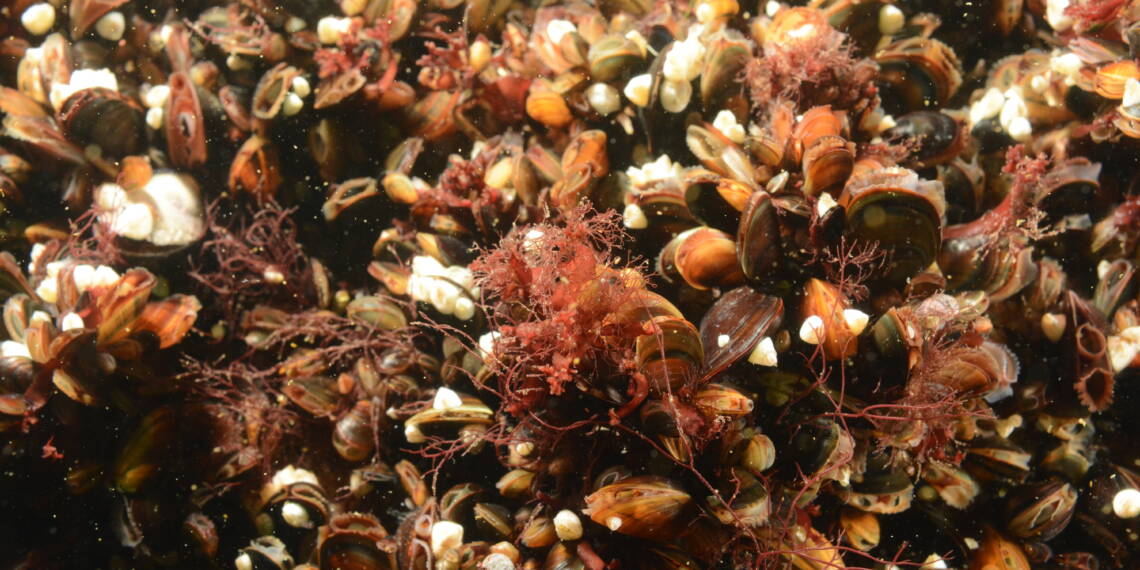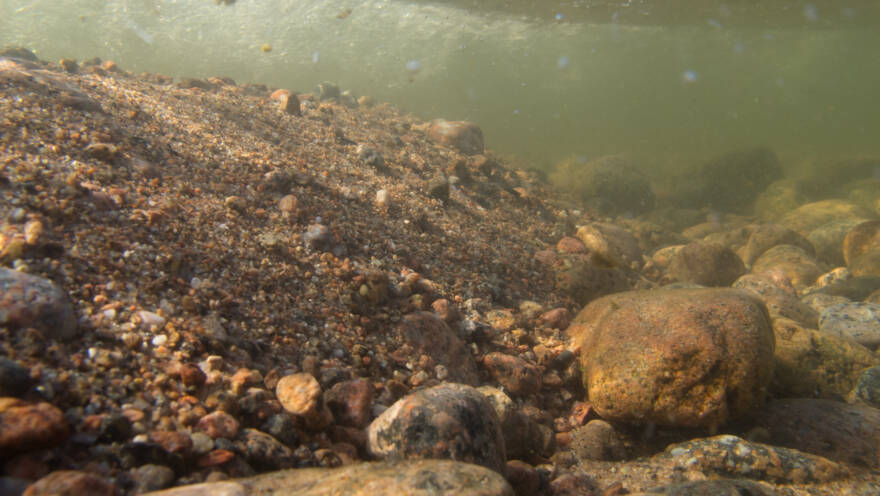
Blue mussels are one of the most important and common benthic animals in the Baltic Sea
In the Baltic Sea, the blue mussel often lives in dense communities in areas ranging from a few square metres to hectares, where they compete with algae for hard surfaces to which they can attach. Since mussels do not photosynthesise their food but filter it from the water instead, their highest densities occur below the zone lit by sunlight, at depths ranging from 8 to 12 metres, where algae are scarce.
Occasionally, however, mussel communities, which are typical of hard surfaces, can also be found on sand and gravel and sometimes even on soft deposits. In this case, the mussels occurring on the soft bottom sediments are attached to one other instead of the bottom substrate. Individual mussels may also be found attached to aquatic plants.
The densest mussel communities on the Finnish coastline are located in southwestern Finland, where the water salinity does not fall below the 5 ‰ limit required by mussels to survive. Although isolated individuals occur all the way north as far as the Kvarken, blue mussels are no longer found in the almost fresh waters of the Bay of Bothnia. Similarly, blue mussels decrease in occurrence in the inner reaches of the eastern Gulf of Finland, where it is replaced by the freshwater zebra mussel, i.e. Dreissena polymorpha.
The blue mussel of the Baltic Sea is a hybrid
The blue mussel surviving in the brackish water of the Baltic Sea is a cross between two oceanic species, i.e. Mytilus trossulus x edulis. The shell is oblong-triangular in shape and varies in colour from dark blue to black. Marine mussels are larger than the blue mussels of the Baltic Sea, which measure only 1 to 4 centimetres in length.
Blue mussels proliferate by releasing their sex cells or gametes into the water for fertilisation. Water currents carry the tiny larvae to new areas, where they eventually sink to the bottom to attach to their final growing habitat. The attachment surface must first be free from filamentous algae, fine sediments, as well as other animals for the mussel to successfully anchor itself and a new colony to form.
The blue mussel offers food and shelter to many other animals
Blue mussels are one of the key species in the Baltic Sea, and their communities form so-called key habitats also. Abundant colonies provide protection and nourishment for many other invertebrates, such as snails (Hydrobia spp., Theodoxus fluviatilis), and crustaceans, such as amphipods (Gammarus spp.) and isopods (Idotea spp.), as well as various species of marine worms.
In addition, clumps of blue mussels form small niches on the bottom which are filled with soft deposits in which soft-bottom clam species, such as the Baltic tellin (Limecola balthica) and the lagoon cockle (Cerastoderma glaucum), as well as the ragworm, i.e. (Hediste diversicolor), can survive.
Blue mussels are eaten by eider and long-tailed ducks, as well as many cyprinid fish species and flatfish, such as the flounder.
The video requires marketing cookies to be enabled. Please enable cookies to watch it.
Excess eutrophication is also detrimental to mussels
Although a mild increase of nutrients in the water can benefit mussels, prolonged eutrophication is also harmful to them. Also, due to eutrophication, mussel communities may become smothered by the explosive growth of filamentous algae, as well as the increase in accumulated sediment.
Did you know?
Mussels are thought to filter the amount of water corresponding to the entire mass of the Baltic Sea every year. The slow-moving and relatively long-lived mussel is a good indicator of changes in water quality as they absorb water nutrients, as well as pollutants.
Species associated with blue mussel communities
- Baltic tellin (Macoma balthica)
- Lagoon cockle (Cerastoderma claucum)
- Ragworm (Hediste diversicolor)
- Eider duck (Somateria mollissima)
- Long-tailed duck (Clangula hyemalis)
- Cyprinid fish, i.e. roach, bream, etc. (Cyprinidae)
- Flounder (Platichtys flesus)
-
 Find out more
Find out moreBenthic animals
-
 Find out more
Find out moreSeafloor geology

